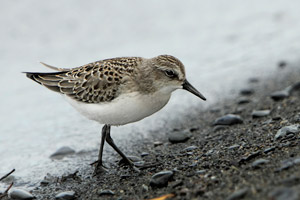
Over 360 species of birds have been spotted throughout the Bay of Fundy region, including such endangered species as the peregrine falcon and the piping plover. The Bay of Fundy is a preferred destination for many birdwatchers, particularly during migration season, due to its prime location along the Atlantic Flyway. It is estimated that between two and three million birds travel along the Atlantic Flyway each year; three-quarters of which stop in the Fundy region, making it the most important stopping point along the Eastern seaboard (Thurston, 1990).
Mary’s Point Bird Sanctuary – situated along the Fundy shores in Albert County, New Brunswick between Fundy National Park and the popular Hopewell Rocks – is one of the best places along the Bay for viewing shorebirds, particularly the semipalmated sandpiper.

Hundreds of thousands of semipalmated sandpipers stop in Fundy each summer during their migration from their Arctic breeding grounds to their winter home of South America. Why? Well, quite simply they come here to get fat. The birds follow the tide line as it advances and recedes. At high tide the sandpipers roost but as the Fundy tide recedes, these little birds scurry from one hole to the next. Using sight and their relatively long bills, each sandpiper consumes between 9600-23000 mud shrimp each tide cycle. During their time in the Fundy region, the sandpipers will double their lean weight of approximately 20 grams in order to increase their fat reserves to complete the remaining 4000km of their migration, non-stop.

In addition to Mary’s Point, these sandpipers have also shown preference for Grande-Anse, Starrs Point and Evangeline Beach. The first semipalmated sandpipers generally do not arrive in Fundy until mid-July.
Another favourite bird sighting in Fundy is the Atlantic Puffin. Spotted nearer the mouth of the Bay, Machias Seal Island is the seasonal home to not only nesting puffins but also nesting arctic and common terns and razorbills. Access to this small island is limited and landing is done at one’s own risk as the terrain can be quite slippery and uneven. The sanctuary is protected by the Canadian Wildlife Service.
If you enjoyed this 20th article in our “52 Reasons to visit the Bay of Fundy” series then we recommend you check out the overview of all the articles in this series. You might also want to use our RSS feed so you won’t miss any articles in the future!
Yvonne Barlock
Wondering if the sandpipers are still feeding along the Bay of Fundy or have they begun their migration south? Am interested in seeing them if they’re still around – in the tide cycle when is the best time? Thank you
Bay of Fundy
Peak migration of adult Semipalmated Sandpipers occurs around the end of July or beginning of August, but they remain common through mid-September. Mostly because the migration of the younger birds peaks several weeks later than the adults.
The best time to see a lot of them together would be when the incoming tide is nearing its highest point. At that time, they are gradually being forced off the mudflats where they feed, and will gather in large numbers on the beach, where they rest in dense formations during high tide.